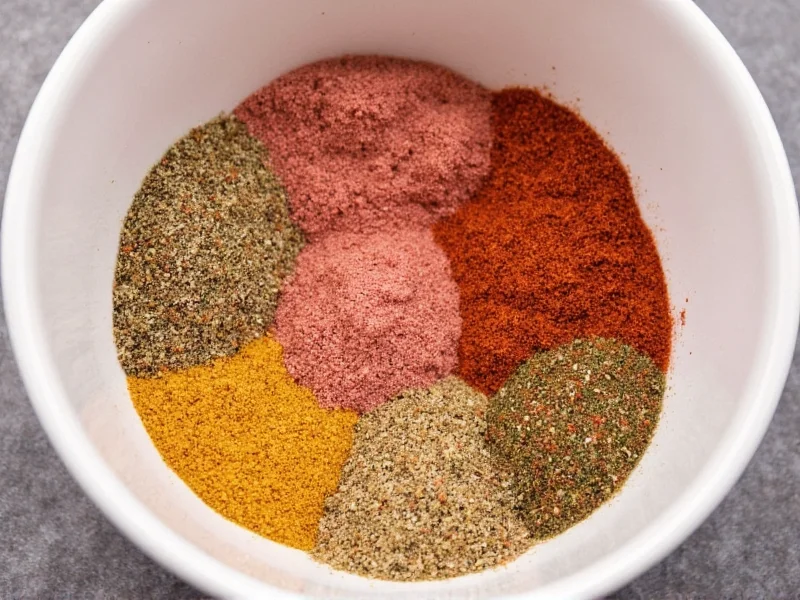Creating exceptional burgers starts with the right seasoning blend. While store-bought options exist, a homemade hamburger seasoning recipe gives you complete control over flavor profiles and ingredient quality. This guide provides a professional-grade seasoning mix that enhances rather than masks the natural beef flavor—a crucial distinction many commercial blends miss.
Why Homemade Hamburger Seasoning Beats Store-Bought
Commercial seasoning blends often contain fillers, excessive salt, and preservatives that compromise both taste and health. A DIY burger spice mix allows you to:
- Avoid unnecessary additives and anti-caking agents
- Customize heat levels to personal preference
- Control sodium content for dietary needs
- Create fresher flavors with premium spices
- Save money compared to specialty store blends
The Ultimate Hamburger Seasoning Recipe
This balanced blend enhances beef's natural umami while adding complexity without overwhelming the palate. The precise ratios ensure consistent results every time you make burgers.
| Ingredient | Measurement | Key Flavor Contribution |
|---|---|---|
| Paprika | 2 teaspoons | Rich color and subtle sweetness |
| Garlic powder | 1 teaspoon | Earthy depth without raw garlic bite |
| Onion powder | 1 teaspoon | Savory backbone and umami enhancement |
| Dried mustard | 1 teaspoon | Subtle tang that cuts through fat |
| Black pepper | 1 teaspoon | Warm spice note without heat |
| Salt | 1 teaspoon | Flavor enhancer and meat tenderizer |
| Cayenne pepper | 1/2 teaspoon | Controlled heat that complements beef |
Step-by-Step Preparation Guide
- Measure precisely - Use proper measuring spoons (not tableware) for accuracy
- Combine dry ingredients in a small bowl, whisking thoroughly for 30 seconds
- Store properly in an airtight container away from light and moisture
- Use within 3 months for peak flavor (spices lose potency over time)
Proper Usage Techniques
Even the best hamburger seasoning recipe fails with improper application. Follow these professional techniques:
- Use 1-2 tablespoons per pound of ground beef (start with less, you can always add more)
- Mix seasoning into meat gently—overworking creates tough burgers
- Season just before cooking; salt draws out moisture if applied too early
- Reserve some seasoning for finishing after cooking for layered flavor
- For thicker patties, consider a light seasoning rub on the exterior only
Customization Options for Different Palates
This base recipe serves as a foundation you can adapt to various preferences:
Smoky Variation
Replace regular paprika with smoked paprika and add 1/4 teaspoon chipotle powder for a campfire-inspired flavor profile perfect for grilled burgers.
Umami Boost
Add 1/2 teaspoon mushroom powder or 1 teaspoon nutritional yeast for enhanced savory depth—ideal for plant-based blends or lean beef patties.
Southwest Style
Increase cayenne to 1 teaspoon and add 1/2 teaspoon cumin for a Tex-Mex twist that pairs beautifully with pepper jack cheese and avocado.
Critical Mistakes to Avoid
Even experienced cooks make these common errors with hamburger seasoning:
- Over-seasoning - More isn't better; excess spices create bitter, unbalanced flavors
- Using old spices - Stale spices lack potency, leading to bland results despite proper measurements
- Mixing while cold - Bring meat to room temperature before seasoning for even distribution
- Adding liquid ingredients - Wet components like Worcestershire sauce should be added separately, not in dry seasoning mix
- Ignoring meat quality - Premium seasoning can't compensate for poor-quality ground beef
Storage and Shelf Life Guidelines
Proper storage maintains your homemade burger seasoning's potency:
- Use glass or metal containers (plastic can absorb flavors)
- Keep away from heat sources (not above the stove)
- Store in a cool, dark place (not clear jars on open shelves)
- Label with preparation date—maximum shelf life is 3-4 months
- Refresh your blend quarterly for consistent results
Frequently Asked Questions
How much seasoning should I use per pound of ground beef?
Use 1-2 tablespoons of seasoning per pound of ground beef. Start with 1 tablespoon for milder flavor, especially with high-quality beef. For leaner blends or stronger flavor preference, use up to 2 tablespoons. Remember that salt content varies between brands, so adjust accordingly if your blend contains additional salt beyond the recipe.
Can I make this seasoning without salt for dietary restrictions?
Yes, you can create a salt-free hamburger seasoning recipe by omitting the salt and increasing other spices proportionally. Add an extra 1/2 teaspoon of paprika and 1/4 teaspoon each of garlic and onion powder to maintain volume. When using salt-free seasoning, consider adding a light sprinkle of finishing salt after cooking for optimal flavor development without excessive sodium.
Why shouldn't I mix seasoning into the meat too far in advance?
Adding seasoning too early, especially salt, draws moisture from the meat through osmosis. This creates a wet surface that steams rather than sears when cooking, resulting in less flavorful, gray burgers. For best results, season patties immediately before cooking—no more than 15 minutes in advance—to maintain proper texture and achieve that desirable caramelized crust.
What's the difference between this blend and commercial seasoning packets?
Homemade blends avoid the fillers, anti-caking agents, and excessive sodium common in commercial hamburger seasoning packets. Our recipe uses pure spices in balanced proportions that enhance rather than mask beef flavor. Commercial blends often contain 50-100% more salt and may include MSG, sugar, or preservatives. The freshness of individually sourced spices also provides superior flavor complexity compared to pre-mixed packets that lose potency during storage.
Can I use this seasoning for other meats besides burgers?
Absolutely. This versatile dry rub works well with ground turkey, chicken, or plant-based alternatives. For steak, use half the amount as a light rub. It also enhances meatloaf, meatballs, and taco filling. When using with poultry, reduce cayenne by half and add 1/2 teaspoon dried thyme for better flavor compatibility. The balanced profile makes it adaptable across various protein applications while maintaining its burger-specific optimization.











 浙公网安备
33010002000092号
浙公网安备
33010002000092号 浙B2-20120091-4
浙B2-20120091-4